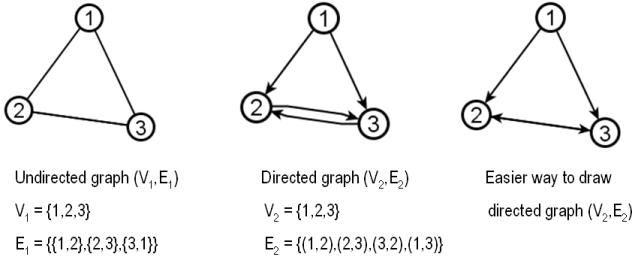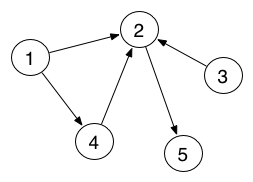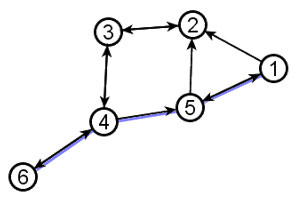CSCI-1080 Intro To CS: World Wide Web
Saint Louis University, Department of Computer Science
Graph Theory
A graph is a formal mathematical representation of a network (“a collection of objects connected in some fashion”).
 |
Each object in a graph is called a node (or vertex). Corresponding to the connections (or lack thereof) in a network are edges (or links) in a graph. Each edge in a graph joins two distinct nodes.
More formally, we define a graph G as an ordered pair  where
where
V is a set of nodes (vertices).
E is a set of edges (links).
Each edge is a pair of vertices.
In other words, each element of E is a pair of elements of V. Example: The picture above represents the following graph:
Loops: An edge with identical endpoints is a loop: We disallow loops: any graph G=(V,E) by definition has no loops in its set of edges E.
Undirected and Directed
Undirected graph: The edges of a graph are assumed to be unordered pairs of nodes. Sometimes we say undirected graph to emphasize this point. In an undirected graph, we write edges using curly braces to denote unordered pairs. For example, an undirected edge {2,3} from vertex 2 to vertex 3 is the same thing as an undirected edge {3,2} from vertex 3 to vertex 2.
Directed graph: In a directed graph, the two directions are counted as being distinct directed edges. In an directed graph, we write edges using parentheses to denote ordered pairs. For example, edge  is directed from 2 to 3 , which is different than the directed edge
is directed from 2 to 3 , which is different than the directed edge  from 3 to 2. Directed graphs are drawn with arrowheads on the links, as shown below:
from 3 to 2. Directed graphs are drawn with arrowheads on the links, as shown below:
 |
Neighborhood and Degree
Two vertices are called adjacent if they share a common edge, in which case the common edge is said to join the two vertices. An edge and a vertex on that edge are called incident.
See the 6-node graph for examples of adjacent and incident:
 |
Nodes 4 and 6 are adjacent (as well as many other pairs of nodes)
Nodes 1 and 3 are not adjacent (as well as many other pairs of nodes)
Edge {2,5} is incident to node 2 and node 5.
The neighborhood of a vertex v in a graph G is the set of vertices adjacent to v. The neighborhood is denoted
 . The neighborhood does not include v itself. For example, in the graph below
. The neighborhood does not include v itself. For example, in the graph below  and
and  .
.
The degree of a vertex is the total number of vertices adjacent to the vertex. The degree of a vertex v is denoted  . We can equivalently define the degree of a vertex as the cardinality of its neighborhood and say that for any vertex v,
. We can equivalently define the degree of a vertex as the cardinality of its neighborhood and say that for any vertex v,  .
.
The following is a vertex degree table of the graph above.
| Vertex ID | Vertex Degree |
| 1 | 2 |
| 2 | 3 |
| 3 | 2 |
| 4 | 3 |
| 5 | 3 |
| 6 | 1 |
In a directed graph, we define degree exactly the same as above (and note that “adjacent” does not imply any direction or lack of direction).
In a directed graph it is important to distinguish between indegree and outdegree. Recall that any directed edge has two distinct ends: a head (the end with an arrowhead) and a tail. Each end is counted separately. The sum of head endpoints count toward the indegree of a vertex and the sum of tail endpoints count toward the outdegree of a vertex.
 |
The directed graph above has the following degrees, indegrees, and outdegrees:
| Vertex ID | Vertex Degree | Indegree | Outdegree |
| 1 | 2 | 0 | 2 |
| 2 | 4 | 3 | 1 |
| 3 | 1 | 0 | 1 |
| 4 | 2 | 1 | 1 |
| 5 | 1 | 1 | 0 |
Density and Average Degree
The density of a graph  measures how many edges are in set
measures how many edges are in set  compared to the maximum possible number of edges between vertices in set
compared to the maximum possible number of edges between vertices in set  .
.
Density is calculated as follows:
An undirected graph has no loops and can have at most  edges, so the density of an undirected graph is
edges, so the density of an undirected graph is  .
A directed graph has no loops and can have at most
.
A directed graph has no loops and can have at most  edges, so the density of a directed graph is
edges, so the density of a directed graph is  .
.
The average degree of a graph  is another measure of how many edges are in set
is another measure of how many edges are in set  compared to number of vertices in set
compared to number of vertices in set  . Because each edge is incident to two vertices and counts in the degree of both vertices, the average degree of an undirected graph is
. Because each edge is incident to two vertices and counts in the degree of both vertices, the average degree of an undirected graph is  .
.
Paths
A path in a graph represents a way to get from an origin to a destination by traversing edges in the graph. For example, in the undirected graph  drawn below, there are many paths from node 6 to node 1. One such path is highlighted with red:
drawn below, there are many paths from node 6 to node 1. One such path is highlighted with red:
 |
We write a path  as an ordered list of directed edges:
as an ordered list of directed edges:  . The first vertex of the first edge of a path is the origin and the second vertex of the last edge is the destination. Both origin and destination are called endpoints of the path.
. The first vertex of the first edge of a path is the origin and the second vertex of the last edge is the destination. Both origin and destination are called endpoints of the path.
Examples:
The red path above is ((6,4), (4,3), (3,2), (2,5), (5,1)); it is a path in G from node 6 to node 1
The blue path below is ((6,4), (4,5), (5,1)); it is also a path in G from node 6 to node 1
 |
Paths in undirected graphs defined formally
Even in an undirected graph (such as the 6-node drawing above), we define a path as an ordered list of directed edges:  . The strict ordering of nodes in the definition of a path corresponds to the order in which nodes and edges are traversed to get from the origin to the destination.
. The strict ordering of nodes in the definition of a path corresponds to the order in which nodes and edges are traversed to get from the origin to the destination.
Let us suppose we have an undirected graph  and an ordered list of directed edges
and an ordered list of directed edges  .
.  is a path in
is a path in  only if the following are true of every directed edge
only if the following are true of every directed edge  in
in  :
:
Directed edge  in
in  corresponds to an undirected edge in
corresponds to an undirected edge in  .
.
In other words,  .
.
If directed edge  is not the last edge in
is not the last edge in  , then let
, then let  be the next edge in
be the next edge in  . Directed edge
. Directed edge  starts with a tail node identical to the head node of
starts with a tail node identical to the head node of  .
.
This means that  and
and  .
.
The final requirement for  to be a path in
to be a path in  is that
is that  cannot revisit any nodes. An ordered list of directed edges that meets the above two requirements and that does revisit nodes is called a walk.
Examples of walks that are not paths, based on the 6-node graph drawn above:
cannot revisit any nodes. An ordered list of directed edges that meets the above two requirements and that does revisit nodes is called a walk.
Examples of walks that are not paths, based on the 6-node graph drawn above:
 is a walk from node
is a walk from node  to node
to node 
 is a walk from node
is a walk from node  to node
to node 
A walk does not have to revisit nodes. Therefore, any path by definition is also a walk.
Paths in directed graphs
A directed path is a path in a directed graph where the directions of edges in the path match the directions of edges in the directed graph. For example, suppose we consider this directed graph:
 |
The blue lines highlight  which is a directed path from
which is a directed path from  to
to  in directed graph G.
in directed graph G.
As a counter-example, consider the same directed graph with a different ordered list of edges that is not a directed path:
 |
In this case, the red lines highlight  ; the
; the  edge of
edge of  – (2,5) – goes the “wrong way”; and so
– (2,5) – goes the “wrong way”; and so  is not a directed path in
is not a directed path in  . We instead refer to
. We instead refer to  as an undirected path in a directed graph. Information Today's “Bow Tie Structure of the Web” article puts it this way: “In an undirected path, hyperlinks can be followed forward or backward, a technique available to search engine spiders but not to a person using a Web browser.”
as an undirected path in a directed graph. Information Today's “Bow Tie Structure of the Web” article puts it this way: “In an undirected path, hyperlinks can be followed forward or backward, a technique available to search engine spiders but not to a person using a Web browser.”
Length
The length of a path is the number of edges that it uses. Note that this definition is merely a restatement of the definition of the length of an ordered list.
Examples:
The length of the red path below is 5
The length of the blue path below is 3
 |
Distance
Given a graph  , The distance
, The distance  between two vertices x and y is the length of the shortest path from x to y, considering all possible paths in
between two vertices x and y is the length of the shortest path from x to y, considering all possible paths in  from x to y.
from x to y.
The distance between any node and itself is  . If there is no path from x to y then
. If there is no path from x to y then  is infinity.
is infinity.
Examples:
In the preceding graph, the distance from 6 to 1 is 3.
There is no path from 6 to 1 shorter than 3.
There is only one path from 6 to 1 with length 3, and that path is ((6,4), (4,5), (5,1)).
There are many longer paths from 6 to 1, none of which has any bearing on the distance from 6 to 1.
In the graph below, the distance from b to c is 2.
There is no path from b to c shorter than 2.
There are multiple paths from b to c of length 2. One such path is ((b,f), (f,c)). There are also many longer paths from b to c.
In the graph below, the distance from a to b is infinity.
There is no path from a to b.
 |
The above examples all rely on small graphs where a simple visual inspection reveals what is the shortest path between any specified pair of nodes. For larger graphs, it is generally not possible to discern shortest paths so easily. Computer science provides algorithms, such as the breadth-first search algorithm, to compute shortest paths (and hence distances) in a graph of any size.
For now, we will limit our calculations of shortest paths to small graphs where visual inspection is easy and a formal algorithmic approach is not necessary.
The contect of this site is licensed under a Creative Commons Attribution-ShareAlike 4.0 International License.

